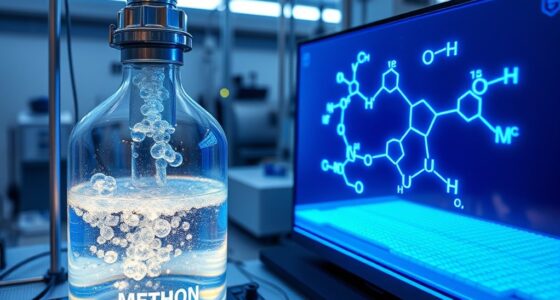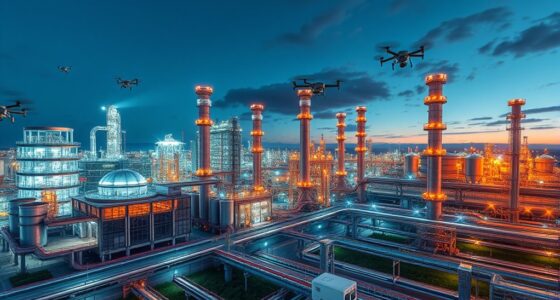Automation and robotics are revolutionizing chemical labs and plants by boosting safety, precision, and efficiency. They reduce human errors, handle hazardous materials safely, and improve process consistency and scalability. Advanced technologies like AI, IoT, and robotic systems enable faster results and lower costs. As automation grows, you’ll find safer, more productive environments. Keep exploring to discover how these innovations are shaping the future of chemical manufacturing and research.
Key Takeaways
- Automation enhances experiment precision, safety, and efficiency in chemical labs and manufacturing plants.
- Advanced technologies like IIoT, AI, and robotics enable real-time monitoring and process optimization.
- Robotic systems reduce human exposure to hazards and automate repetitive or complex tasks.
- Industry leaders are developing smarter, more adaptable robotic solutions for diverse chemical applications.
- Challenges include high initial costs, system integration, and the need for specialized skills.
The Rise of Automation in Chemical Laboratory Operations
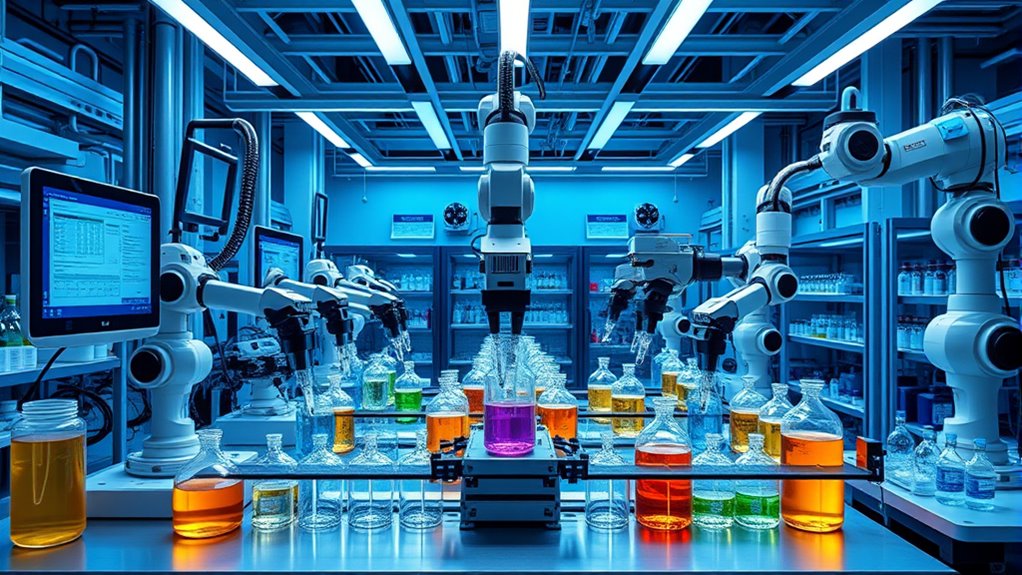
The rise of automation in chemical laboratory operations has transformed how experiments are conducted and data is managed. You now benefit from more precise experiments, as automated systems tightly control reactions, reducing variability and boosting reliability. Utilizing advanced instruments like liquid chromatography-mass spectrometry, automation ensures consistent sample analysis and data collection. Human errors are minimized, resulting in more accurate and reproducible results. Safety improves because automation handles hazardous materials and enforces safety protocols with alarms. Operational efficiency soars since complex workflows are automated, freeing your team for other tasks and cutting downtime. Additionally, automation allows for scalability, processing multiple samples simultaneously and increasing throughput. This evolution not only streamlines operations but also enhances safety and consistency, making chemical labs more efficient and reliable. As a result, you can achieve higher quality outcomes with less manual effort and greater confidence.
Key Technologies Driving Robotics in Chemical Plants
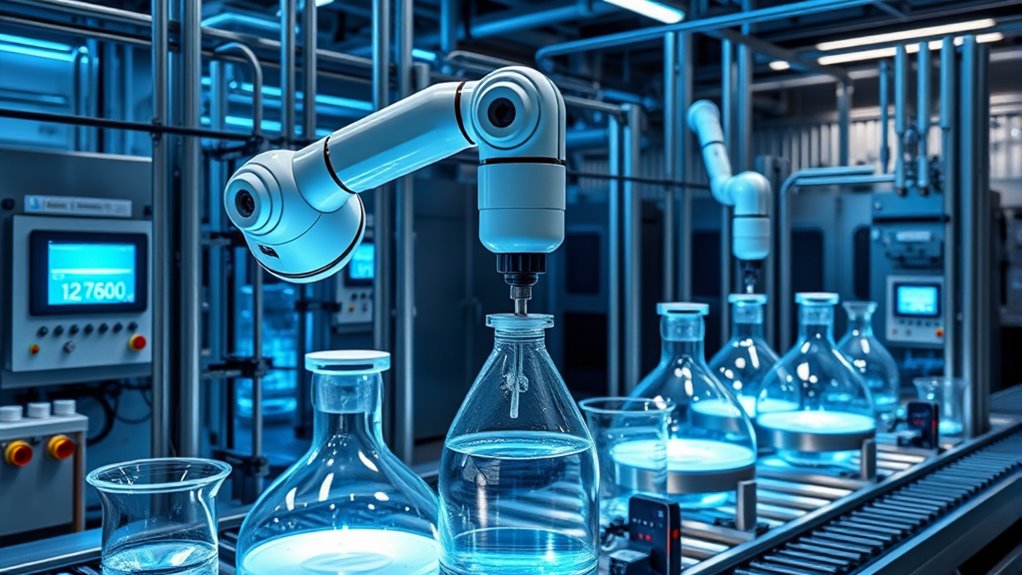
Advancements in robotics and automation are transforming chemical plants by integrating cutting-edge technologies that enhance safety, efficiency, and process control. The Industrial Internet of Things (IIoT) and smart sensors serve as the plant’s central nervous system, providing real-time data on temperature, pressure, and chemical composition. This continuous monitoring allows you to make instant process adjustments and predict maintenance needs. AI and ML analyze large data sets to optimize processes, predict maintenance, and enable real-time decisions. Robotics and autonomous systems reduce human exposure to hazards, handle repetitive tasks, and streamline logistics with Automated Guided Vehicles (AGVs). Meanwhile, Advanced Process Control systems, like Model Predictive Control, optimize reactions and maintain precise conditions, improving yield and reducing waste. Additionally, digital twins are increasingly utilized for simulation and testing of processes before implementation, further enhancing operational safety and efficiency. Together, these technologies create a safer, more efficient, and highly responsive chemical manufacturing environment.
Benefits of Implementing Robotic Systems in Chemical Manufacturing
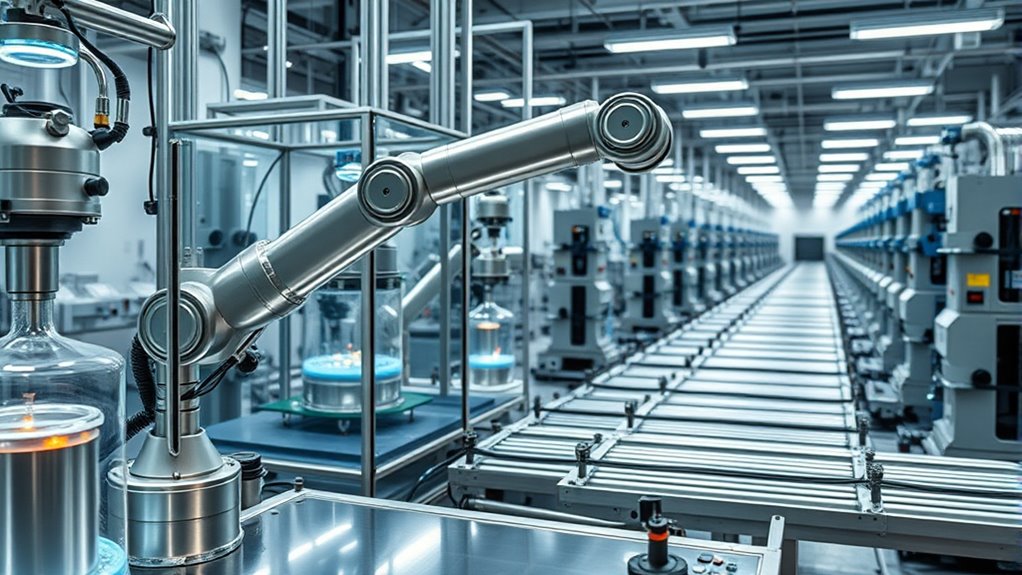
Implementing robotic systems in chemical manufacturing markedly enhances safety by minimizing human exposure to hazardous materials and conditions. Robots handle dangerous substances, reducing accidents and ensuring compliance with safety and environmental regulations. They interact safely with hazardous chemicals, lowering the risk of spills and injuries, which creates a safer, more comfortable workplace. Robots are equipped with sensors and control systems to detect and respond to potential hazards, further improving safety protocols. Additionally, robotic systems improve precision and consistency, decreasing human errors and enhancing product quality. Faster processing and continuous operation boost productivity and competitiveness, while automation reduces waste and minimizes environmental impact through optimized resource use.
Moreover, advancements in AI integration are enabling robots to adapt to complex processes, increasing their effectiveness in diverse chemical environments. Over time, companies see significant cost savings and increased ROI, as robots lower labor and maintenance costs. Overall, automation leads to a safer, more efficient, and environmentally responsible manufacturing environment.
Challenges and Considerations for Automating Chemical Processes
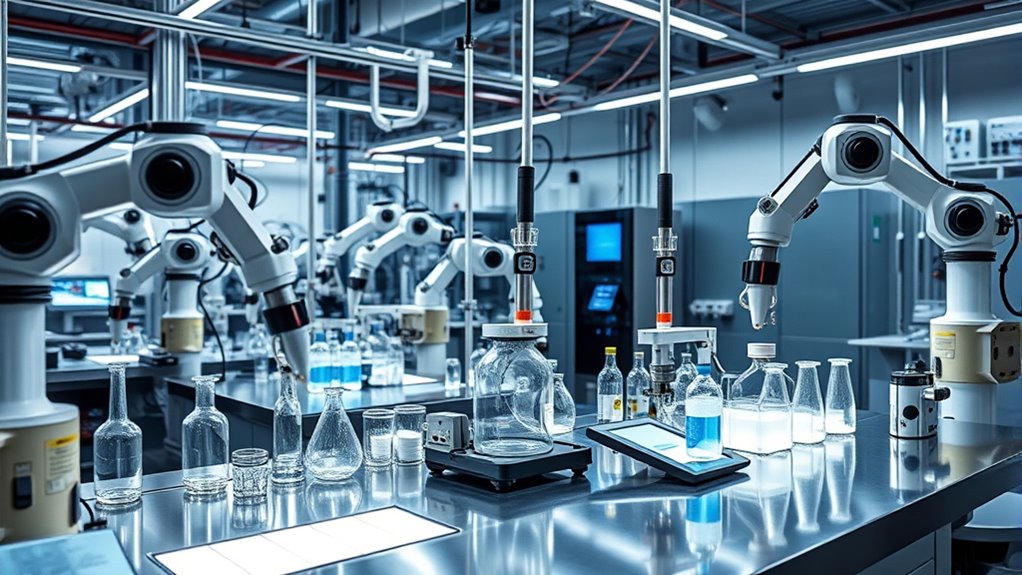
Automating chemical processes presents significant challenges that organizations must carefully consider. The high upfront costs for hardware, software, and infrastructure can be a major barrier, especially for small-to-medium enterprises with limited budgets.
Automating chemical processes involves high initial costs that can hinder small-to-medium enterprises.
Additionally, ROI may take years to realize due to complex implementation timelines and ongoing expenses for maintenance and upgrades.
Chemical processes are inherently complex, requiring automation systems to manage diverse variables and unpredictable reactions, which complicates programming and limits full automation.
Integration with existing infrastructure often proves difficult, as legacy systems may lack compatibility or data interfaces, increasing costs and downtime.
Data management becomes critical, with the need for secure, accurate, and scalable solutions.
Furthermore, the inherent variability of chemical reactions demands adaptable control systems to maintain safety and efficiency, adding another layer of complexity.
Reliability, maintenance, and regulatory compliance remain ongoing concerns, demanding rigorous testing and preventive measures.
Major Players and Innovations Shaping the Future of Chemical Automation
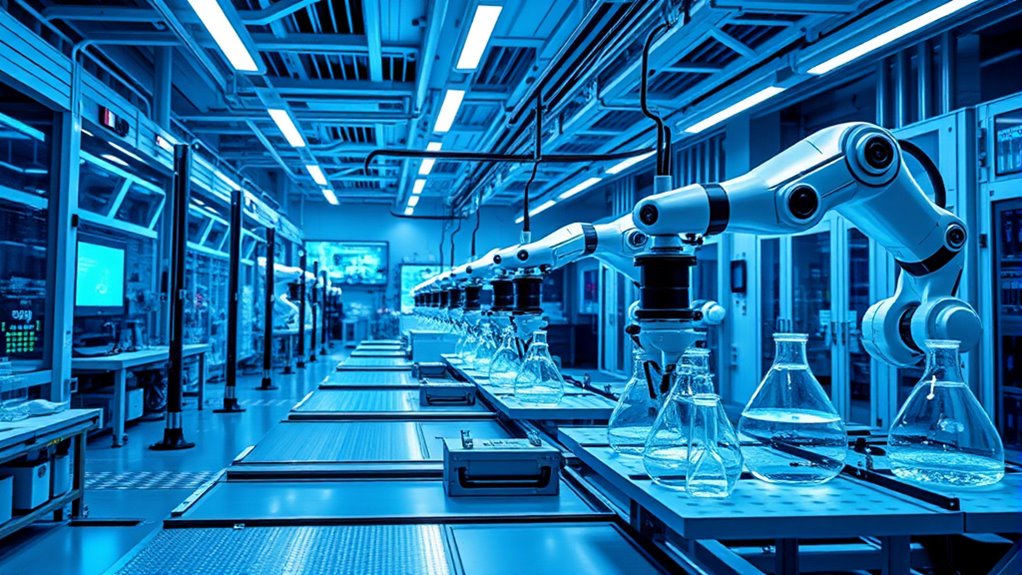
Leading companies in chemical lab automation are driving innovation by developing advanced robotic solutions tailored to meet industry-specific needs. Thermo Fisher Scientific leads with sophisticated automation systems designed for chemical and analytical tasks, while Danaher, through Beckman Coulter, offers integrated platforms that streamline chemical analysis.
Hudson Robotics specializes in flexible systems perfect for repetitive lab tasks. Roche and Becton Dickinson enhance throughput with automated instruments that boost accuracy. Agilent Technologies and PerkinElmer combine precision instruments with robotics to optimize chemical assays.
Innovations focus on high-precision actuators, AI-driven motion controls, and miniaturized components that resist harsh environments. Emerging startups like Machina Labs and GrayMatter Robotics are pushing boundaries with AI-powered, customizable robotic systems, shaping a future where chemical automation becomes smarter, more efficient, and adaptable across diverse applications. Additionally, support hours information can help labs coordinate maintenance and upgrades to ensure continuous operation and minimal downtime.
The Economic and Safety Impact of Robotics in Chemical Environments
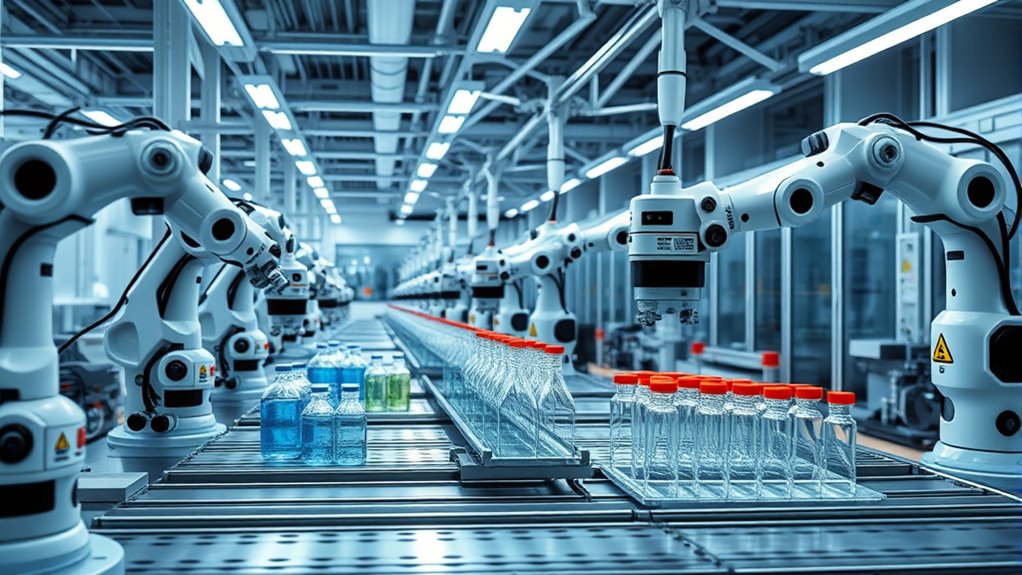
Robotics are transforming chemical environments by boosting safety and efficiency, ultimately delivering significant economic benefits. The global chemical robotics market is projected to reach nearly $679 million in 2025, growing steadily through 2029. China leads the region in revenue, with high robot density—about six robots per million hours worked—enhancing productivity.
Robots reduce risks by handling hazardous tasks, minimizing accidents, and ensuring consistent product quality. They also enable real-time process optimization, lower downtime, and decrease waste, resulting in long-term cost savings. Nutrient retention is an important benefit of raw food diets that emphasizes the importance of preserving natural nutrients.
However, high initial investments and the need for specialized skills pose challenges. Despite these hurdles, advancing robotics technology and growing adoption, including cobots, promise increased safety and economic gains, making automation an essential part of future chemical operations.
Frequently Asked Questions
How Do Robotics Improve Safety in Hazardous Chemical Environments?
Robotics improve safety in hazardous chemical environments by reducing your exposure to dangerous substances. They handle toxic, radioactive, or extreme conditions without risking human health.
Robots follow safety protocols precisely, monitor environments with sensors, and allow for remote maintenance, preventing accidents. This minimizes errors and contamination.
What Are the Training Requirements for Operating Chemical Lab Robots?
You need to master a safety protocol so exhaustive it could save your life in a chemical lab! Complete mandatory safety training covering hazards, emergency procedures, and industry standards.
Get hands-on with robot-specific safety, risk assessments, and barrier setups. Learn to program, troubleshoot, and handle chemicals safely.
Plus, undergo advanced training in sensor calibration and collaborative protocols. This all-encompassing education ensures you’re fully equipped to operate lab robots confidently and safely.
How Do Automation Systems Adapt to Different Chemical Processes?
You can adapt automation systems to different chemical processes by utilizing modular, plug-and-play architectures that allow quick reconfiguration. You’ll integrate real-time data monitoring and advanced software algorithms for precise control, ensuring flexibility.
Robotic handling can be programmed to accommodate various reactions, while open standards facilitate seamless integration with new equipment. This combination helps you respond rapidly to process changes, optimize yields, and meet evolving production needs efficiently.
What Are the Maintenance Challenges for Robotic Equipment in Chemical Plants?
You face tough maintenance challenges that test your skills and patience. Harsh chemicals and extreme conditions accelerate wear, while complex systems and diverse parts keep repairs complicated.
You must stay vigilant with inspections, calibrations, and timely part replacements, often under pressure. Sourcing specialized components and managing evolving technology add stress, but your dedication keeps robotic equipment running smoothly amidst relentless operational demands and environmental hazards.
How Is AI Integrated Into Existing Chemical Automation Workflows?
You can integrate AI into existing workflows by deploying AI agents that automate specific tasks and seamlessly connect with your current systems.
By carefully planning and aligning AI tools with your ERP, SCM, and MES systems, you guarantee smooth data flow and process coordination.
This integration enhances decision-making, reduces manual effort, and improves operational efficiency, allowing you to optimize production, prevent disruptions, and stay competitive in the chemical industry.
Conclusion
As you embrace automation and robotics in chemical labs and plants, you’re opening doors to efficiency and safety like a well-oiled machine. These technologies are transforming the industry much like a catalyst accelerates a reaction, making processes faster and safer. By maneuvering challenges and leveraging innovations, you can stay ahead in this evolving landscape. The future of chemical manufacturing is bright, dynamic, and driven by the power of automation—ready to propel your operations forward.


